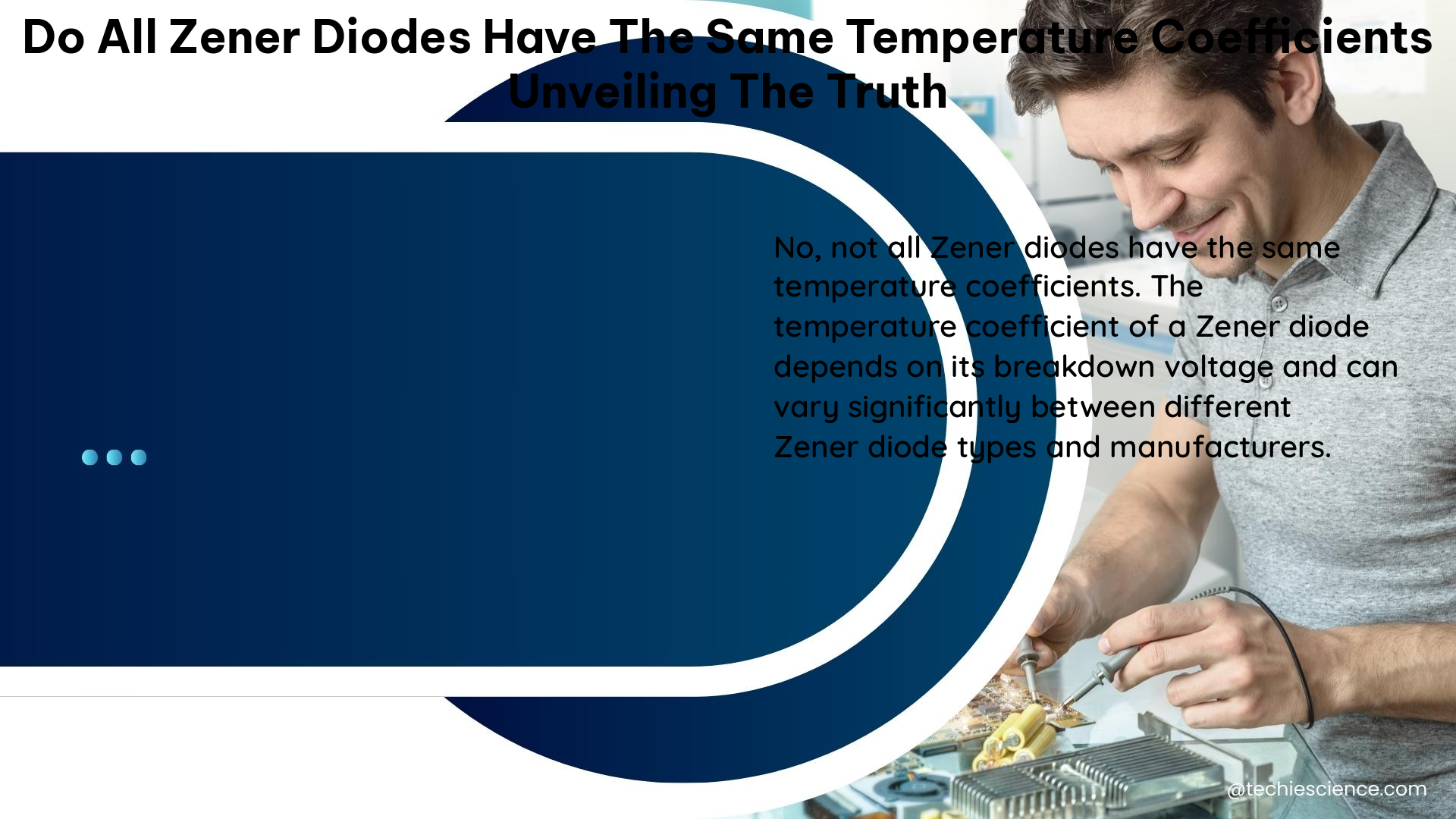The temperature coefficient of a Zener diode is a crucial parameter that determines how the Zener voltage changes with temperature. Contrary to popular belief, not all Zener diodes have the same temperature coefficients. In fact, the temperature coefficient can vary significantly depending on the breakdown voltage of the diode.
Understanding Zener Diode Temperature Coefficients
The temperature coefficient of a Zener diode is typically expressed in millivolts per degree Celsius (mV/°C). This value indicates how much the Zener voltage changes for a given change in temperature.
Zener Diodes with Breakdown Voltages Below 5.6V
For Zener diodes with breakdown voltages below 5.6V, the temperature coefficient is typically negative. This means that as the temperature increases, the Zener voltage decreases. This behavior is attributed to the Zener effect, which is the dominant mechanism in these diodes.
The temperature coefficient of a 4.7V Zener diode is close to that of the emitter-base junction of a silicon transistor, around -2 mV/°C. This means that for every 1°C increase in temperature, the Zener voltage of a 4.7V diode will decrease by approximately 2 millivolts.
Zener Diodes with Breakdown Voltages Above 5.6V
For Zener diodes with breakdown voltages above 5.6V, the temperature coefficient is typically positive. This means that as the temperature increases, the Zener voltage also increases. This behavior is due to the avalanche effect, which is the dominant mechanism in these diodes.
The temperature coefficient of a 75V Zener diode is approximately 10 times that of a 12V diode. For example, a 75V Zener diode may have a temperature coefficient of around +10 mV/°C, while a 12V diode may have a temperature coefficient of around +1 mV/°C.
Zener Diodes with a Breakdown Voltage of 5.6V
In the case of a 5.6V Zener diode, both the Zener effect and the avalanche effect are present, and their temperature coefficients nearly cancel each other out. This makes the 5.6V Zener diode particularly useful in temperature-critical applications, as its Zener voltage remains relatively stable over a wide temperature range.
The temperature coefficient of a 5.6V Zener diode is typically around ±0 mV/°C, meaning that the Zener voltage remains almost constant with changes in temperature.
Dependence on Operating Current
It’s important to note that the temperature coefficient of a Zener diode can also depend on the operating current of the diode. For example, the temperature coefficient of a Zener diode is typically -2.2 to -2.3 mV/°C when measured on a diode range of a multimeter at a known temperature.
As the operating current increases, the temperature coefficient may become less negative or even positive, depending on the breakdown voltage of the diode. This is because the Zener effect and the avalanche effect can be influenced by the operating current.
Practical Implications

The variation in temperature coefficients among Zener diodes has important implications for their use in electronic circuits. Designers must carefully select the appropriate Zener diode based on the specific requirements of their application, such as the desired voltage regulation, temperature range, and current requirements.
For applications that require a stable reference voltage over a wide temperature range, Zener diodes with a breakdown voltage around 5.6V are often the best choice, as their temperature coefficients are close to zero. On the other hand, Zener diodes with higher breakdown voltages may be more suitable for applications where a positive temperature coefficient is desirable, such as in temperature compensation circuits.
Conclusion
In summary, the temperature coefficient of a Zener diode is not a universal constant, but rather a variable that depends on the breakdown voltage of the diode. Zener diodes with breakdown voltages below 5.6V typically have negative temperature coefficients, while those with breakdown voltages above 5.6V have positive temperature coefficients. The 5.6V Zener diode is a special case, where the temperature coefficients of the Zener effect and the avalanche effect nearly cancel each other out, making it useful in temperature-critical applications.
Understanding the nuances of Zener diode temperature coefficients is crucial for designers working with these devices, as it allows them to select the most appropriate Zener diode for their specific circuit requirements.
References:
- Wikipedia. (n.d.). Zener diode. In Wikipedia. https://en.wikipedia.org/wiki/Zener_diode
- EEVblog. (2017, July 3). Zener diode temperature coefficient versus diode operating current. EEVblog. https://www.eevblog.com/forum/metrology/zener-diode-temperature-coefficient-versus-diode-operating-current/
- Texas Instruments. (n.d.). Application Note 56 1.2V Reference. Texas Instruments. https://www.ti.com/lit/an/snva514/snva514.pdf?ref_url=https%253A%252F%252Fwww.google.hu%252F&ts=1695895875306
- Electronics Stack Exchange. (2022, August 16). Why is a Zener diode’s temperature coefficient ±0mV/K at approximately 6V? Electronics Stack Exchange. https://electronics.stackexchange.com/questions/631406/why-is-a-zener-diodes-temperature-coefficient-%C2%B10mv-k-at-approximately-6v
- Microsemi. (n.d.). Zener Voltage Regulation with Temperature. Microsemi. https://www.microsemi.com/document-portal/doc_view/14628-zener-voltage-regulation-with-temperature

The lambdageeks.com Core SME Team is a group of experienced subject matter experts from diverse scientific and technical fields including Physics, Chemistry, Technology,Electronics & Electrical Engineering, Automotive, Mechanical Engineering. Our team collaborates to create high-quality, well-researched articles on a wide range of science and technology topics for the lambdageeks.com website.
All Our Senior SME are having more than 7 Years of experience in the respective fields . They are either Working Industry Professionals or assocaited With different Universities. Refer Our Authors Page to get to know About our Core SMEs.